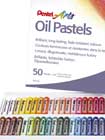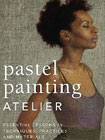
Declined in thousands of colors and textures, pastels are perfect creation tools to develop creativity. BIg, medium, small, round or square ... Pastels come in very many forms. But there are mainly two families of pastels: the dry pastels and oil pastels.The dry pastels are made primarily of pigments, plus a small quantity of binder.
This is the predominant pigment that allows the pastel to have this relatively dry appearance. This type of pastel is mainly characterized for its rich colors and intensities. They are very dusty, which can easily and quickly build large flat areas of color. They can quickly remove large solids and multiply the effects by varying the strength and thickness of the plot. The pastels are sorted by color but it is important to note that each manufacturer codifies color according to its own criteria. To be sure to buy the right color, it is advisable to refer to the color chart. In some cases, the head color represent pure color, and the following will be degraded with white.
Other times, manufacturers use the letters to better classify colors: the first letter indicates the pure color, the second shows the darker shades and finally the third is used to indicate the light shades.
It is possible to cut the dry pastels to make fine and precise routes and more easily raise the level of details. To easily flatten large colored masses, it is advisable to use the pastel on the horizontal support.
Then come the oil pastels. Unlike dry pastels, pigments are here related to the oil, thereby providing greater stability as generally less brittle. They come in the form of rods, larger or smaller, and softer than hard pastels, approaching the lipstick texture. The color available is smaller than pastels but there is still a very wide range to unleash your creativity. Because of their higher fat composition, the handling of oil pastels is also different from that of pastels. Note that it is possible to combine oil pastels and oil painting as they have the same binder.This adds additional details as well as playing on the effects of textures.
It is also possible to dissolve with a little turpentine or white spirit to mix more easily and thus blend perfectly with oil paint or other pastels. You can choose to use directly on the paper to make paths or solids, or deduct some pastels on the tip with a brush and spread with a little turpentine or white spirit. Finally, note that the oil pastels require fewer sprays over dry pastels and their lifespan is generally higher.





